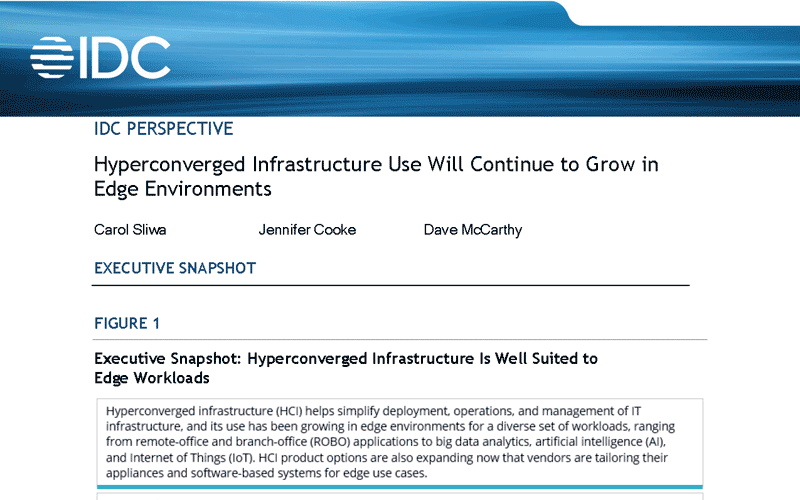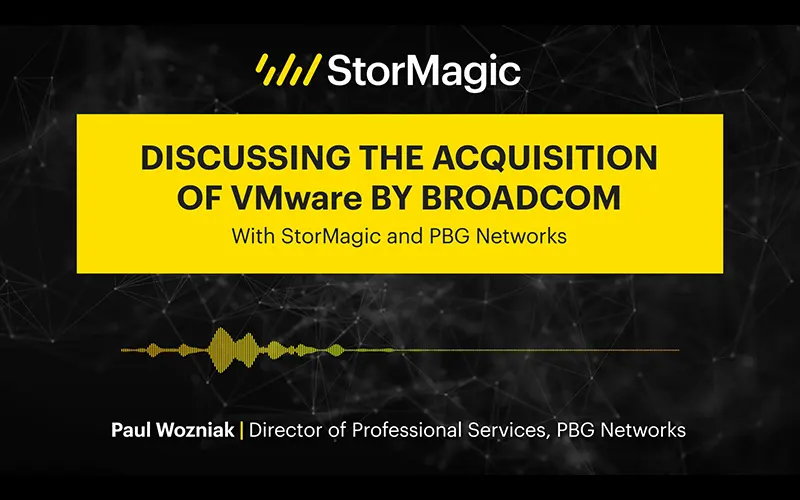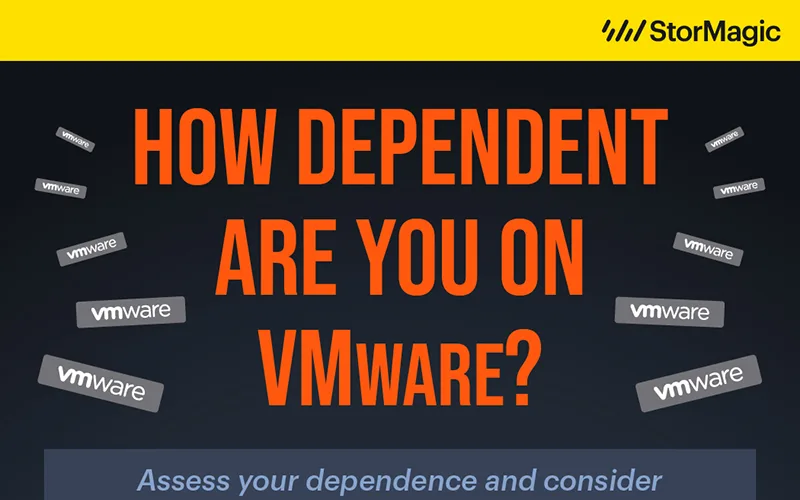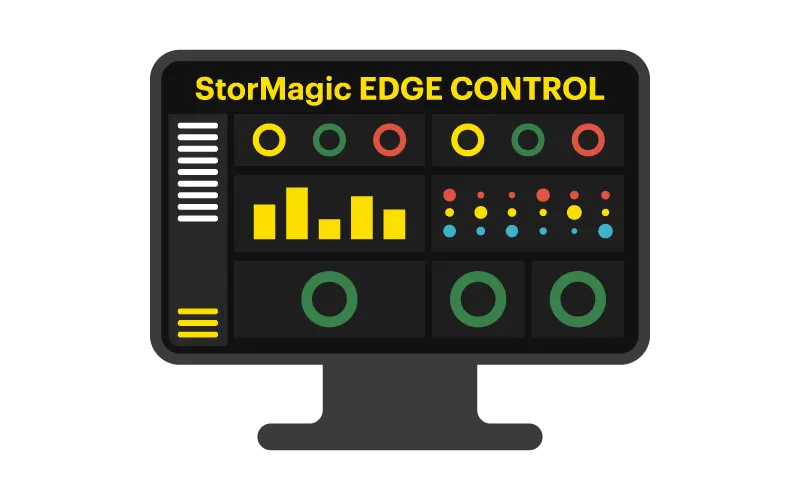The IDC Perspective report, Hyperconverged Infrastructure Use Will Continue to Grow in Edge Environments (doc #US46034120, December 2022), on hyperconverged infrastructure at the edge is out, delving into the marketplace and what businesses looking to deploy this technology at their own edge sites should be looking for in their chosen vendors’ offerings. Growing fast, hyperconverged infrastructure can help businesses tackle the many edge problems like managing and protecting the vast swathes of data coming in from the edge.
But this explosion in hyperconverged solutions for the edge has created potential confusion for customers thanks to the overwhelming number of offerings now available, all promising to be the best fit for their organization. To help provide some clarity over what constitutes a good HCI solution for the edge, IDC recommends the following:
- Customers should keep an eye out for the latest developments, including ruggedized appliances designed for harsh environments.
- Seek out products that offer flexible deployment and unified cloud-based management options across core, edge, and hybrid multi-cloud environments to more effectively manage unstructured data from workloads such as analytics and AI.
- Carefully assess edge workloads from a performance standpoint and seek out options with the latest CPU/GPU options, fast flash-based solid state drives (SDDs), and high-speed networking if your edge appliances require high IOPS and low latency.
What is hyperconvergence?
According to IDC, hyperconverged infrastructure (HCI) combines hypervisor, compute, networking, and storage technologies, encompassing them into a single system. The market intelligence provider notes that there are a variety of different vendor offerings in this space, with typical offerings having a minimum of three server nodes to obtain high availability. For users with more modest infrastructure needs (e.g those operating in remote offices and branch offices (ROBO)), there are HCI options with the ability to run on one or two server nodes per site as well.
Thanks to their simplified deployment and management, reduced on-site maintenance for those deploying in harsh or remote sites, and low-cost hardware, to name a few, these hyperconverged solutions have become a popular alternative to three-tier SAN/NAS storage options.
What is the edge and where is it?
IDC refers to the edge as “a distributed computing paradigm that includes the deployment of infrastructure as close as necessary to where data is generated and consumed.” An example of this includes placing compute infrastructure on a device or machine that processes data where it’s created or close to where it’s created in infrastructure that resides in telco or colocation facilities. These models fall into two broad categories: the public or dedicated cloud and the telco edge. Both categories can be split into four further subsections; the former into enterprise edge and industrial edge, and the latter into device edge and tactical edge. Edge infrastructure can help minimize latency or meet the requirements for compliance and data sovereignty.
Edge environments can span a range of locations including core public/private cloud, regional/metro cloud, MEC, on-premises, and on-device.
Why move to the edge?
Key factors found by IDC that drive enterprises to invest in edge resources are latency, cost, and data sovereignty. According to IDC EdgeView research, 67% of organizations plan on investing more in edge resources through 2023, with spending expected to rise by 37% on average. Important drivers for this growth in edge infrastructure include video cameras, sensors, machines, and IoT devices generating significantly more data than the available bandwidth to transmit it. In order to avoid costly and difficult migrations to the main datacenter, enterprises need to process and analyze this data at the edge closer to its point of creation.
Today edge computing technologies are used across a diverse range of industries including retail spaces, offices, and manufacturing sites to name a few. Due to the risk of security and data vulnerabilities and challenges faced by IT staff, edge infrastructure is typically managed separately from cloud and core environments.
Why use hyperconvergence at the edge?
Due to constraints on space, the lack of IT staff to perform maintenance and updates, and some environments being harsh, HCI providers today are creating solutions that are simpler to manage and operate and target a broad range of environments and use cases, such as reporting on remote oil rigs and maintaining high availability in small offices and retail stores. Good candidates for hyperconverged systems fitted with the last high-performance processors and flash storage technology include demanding workloads like artificial intelligence and machine learning.
Today, customers have greater choice over which HCI solution to go for, empowering them to select one that’s the best fit for their current needs. There’s a wide range of hyperconverged solutions, with many vendors now configuring their systems with edge-specific SKUs including two-server node and single-server node options, high-capacity SKU options, and ruggedized appliances for harsh environments. Many suppliers focus on software, with many key players partnering with major infrastructure providers to run their hardware. Some even give customers the option to run their solution on general-purpose, secondhand, or existing hardware instead, helping them cut their upfront costs further. Additionally, there are also vendors who offer HCI solutions that support more than one hypervisor, integrated container management, or even orchestration tools.
IDC’s key takeaways and overall market analysis
There are vast differences and developments occurring in the edge space today, with IDC predicting the adoption of hyperconverged infrastructure to grow at edge sites for ROBO applications, virtual desktops, analytics, artificial intelligence, and IoT.
Hyperconverged infrastructure can ease provisioning, scaling, and management by combining compute, storage, and networking together. Other expected benefits include a reduction in costs and datacenter footprint. HCI systems can also support high-performance configurations to handle demanding mission-critical workloads.
Finally, IDC predicts that vendors in this space will continue to tailor their appliances and software-based products to make them more robust and compatible with harsh edge environments. This is believed by the market intelligence provider to enable an expansion of the choices that enterprises have to meet the diversity of their needs.




